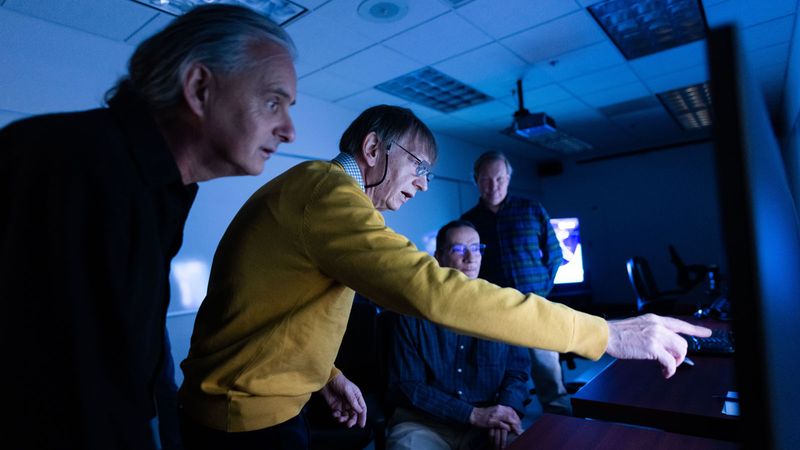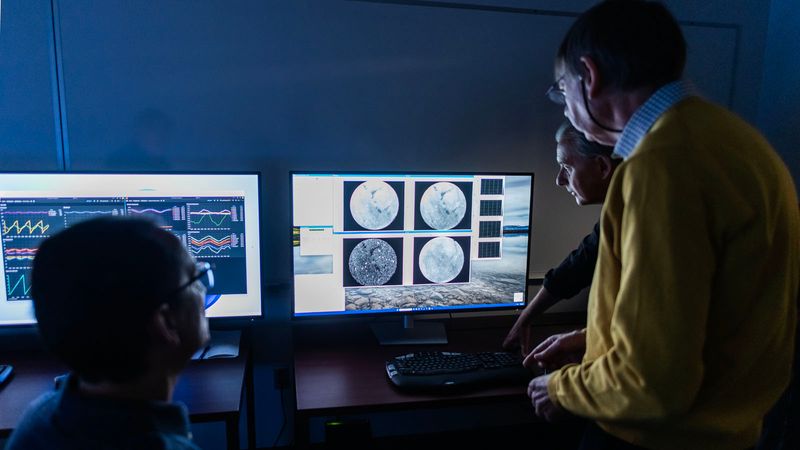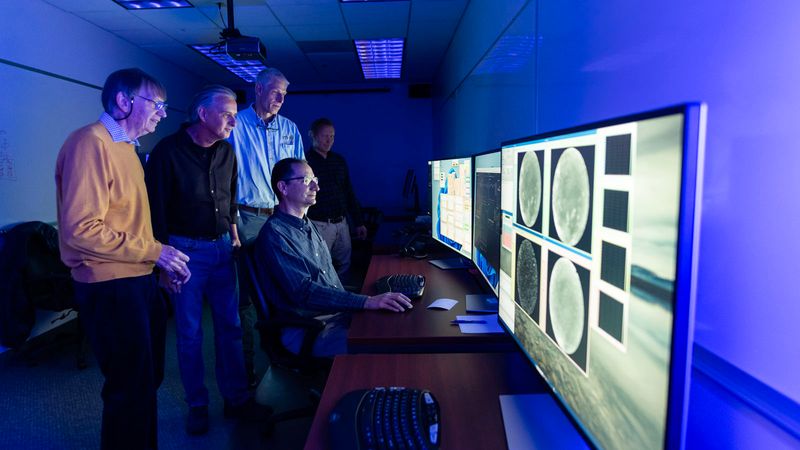
AWE Principal Investigator Ludger Scherliess and Emeritus Principal Investigator Michael Taylor of USU’s College of Science, along with Ground Systems & Mission Operations Manager Pedro Sevilla and Systems Engineer Harri Latvakoski from SDL, are pictured observing some of the first live images captured by AWE from the ISS. The images are transmitted to AWE’s Mission Operations Center at SDL facilities on USU’s Innovation Campus. (Photo Credit: SDL/Allison Bills)
Utah State University’s Space Dynamics Laboratory announced that NASA’s Atmospheric Waves Experiment, or AWE, has captured initial images of the mesosphere from the International Space Station. Known as “first light,” the milestone confirms that the SDL-built AWE instrument is functioning as designed following installation on the ISS.
“First light represents a seminal milestone following a six-year effort to design, build, and test the four infrared telescopes and subsystems that make up AWE’s space-based instrument, the Advanced Mesospheric Temperature Mapper,” said Pedro Sevilla, AWE’s mission operations manager at SDL. “It has been a privilege for the men and women of SDL to work in partnership with the Heliophysics Division of NASA’s Science Mission Directorate and USU’s College of Science to capture the first images for this important mission, which will help scientists better understand the interplay between Earth weather and space weather.”
On November 9, the AWE instrument was launched in a SpaceX Cargo Dragon onboard a Falcon 9 rocket from Cape Canaveral Space Force Station as part of SpaceX’s 29th Commercial Resupply Mission. Two days later, the Cargo Dragon docked with the ISS, and on November 18, AWE was installed on the space station.
The mission’s first objective is to quantify the seasonal and regional variabilities of atmospheric gravity waves (AGWs) near the mesopause, approximately 87 kilometers above Earth. AWE’s images of these waves from space will provide scientists with new information about the phenomena and their far-reaching impacts. With AWE data, researchers will study the occurrence of AGWs throughout the year, examining their energy and momentum across seasons and global locations. Scientists will also study how these waves, which are generated by weather events on Earth, are formed and transported through Earth’s atmosphere.
Another scientific objective seeks to estimate the broader role of AGWs in the region of the upper atmosphere known as the ionosphere-thermosphere-mesosphere. Initial studies have shown that the waves contribute to ionospheric variability, impacting GPS navigation, tracking, and communication systems. The AWE mission aims to uncover more about the influence of AGWs on space weather, which can affect operational systems that rely on radio frequency waves, such as communication and Earth observation satellites.
“We are thrilled to see these initial images from AWE. This data will provide the first observations of these types of atmospheric gravity waves on a global scale from space, and we can only imagine the discoveries that will follow,” said AWE Principal Investigator Dr. Ludger Scherliess. “These images might provide us with the missing link in our understanding of the connection between weather on the ground and weather at the edge of space.”
Scherliess leads the AWE mission from USU’s College of Science. SDL is responsible for AWE’s total project management, systems engineering, safety and mission assurance, and on-orbit operations.
AWE is a Mission of Opportunity under NASA’s Heliophysics Explorers Program, which conducts innovative, streamlined scientific investigations by developing instrumentation to answer focused science questions that augment and complement the agency’s larger missions. AWE joins a fleet of heliophysics missions positioned at key places around the solar system, which together seek to understand the way the constant outflow of energy and particles from our Sun affects Earth and interplanetary space — information that not only teaches us more about our astrophysical neighborhood, but helps protect astronauts and technology in space.
For more information about the AWE mission, visit www.awemission.org.
USU’s Department of Physics is among six academic departments of the College of Science. As part of a land- and space-grant university, the college’s mission is to create, share, and apply new knowledge to inspire scientific solutions to global challenges. USU physics students develop valuable research and critical thinking skills with professors engaged in world-class research programs. For more information, visit www.physics.usu.edu.
Headquartered on Utah State University’s Innovation Campus in North Logan, UT, the Space Dynamics Laboratory is a nonprofit organization and a Department of Defense University Affiliated Research Center owned by USU. More than 1,000 dedicated SDL engineers, scientists, business professionals, and student employees solve technical challenges faced by the military, science community, and industry and support NASA’s vision to explore the secrets of the universe for the benefit of all. SDL has field offices in Albuquerque, NM; Chantilly, VA; Dayton, OH; Huntsville, AL; Ogden, UT; and Stafford, VA. For more information, visit www.sdl.usu.edu.
The material is based upon work supported by the National Aeronautics and Space Administration under Contract Number 80GSFC18C0007. Any opinions, findings, and conclusions or recommendations expressed in this material are those of the author(s) and do not necessarily reflect the views of NASA.


Contact
- SDL Public Relations
- (435) 713-3054
- pr@sdl.usu.edu